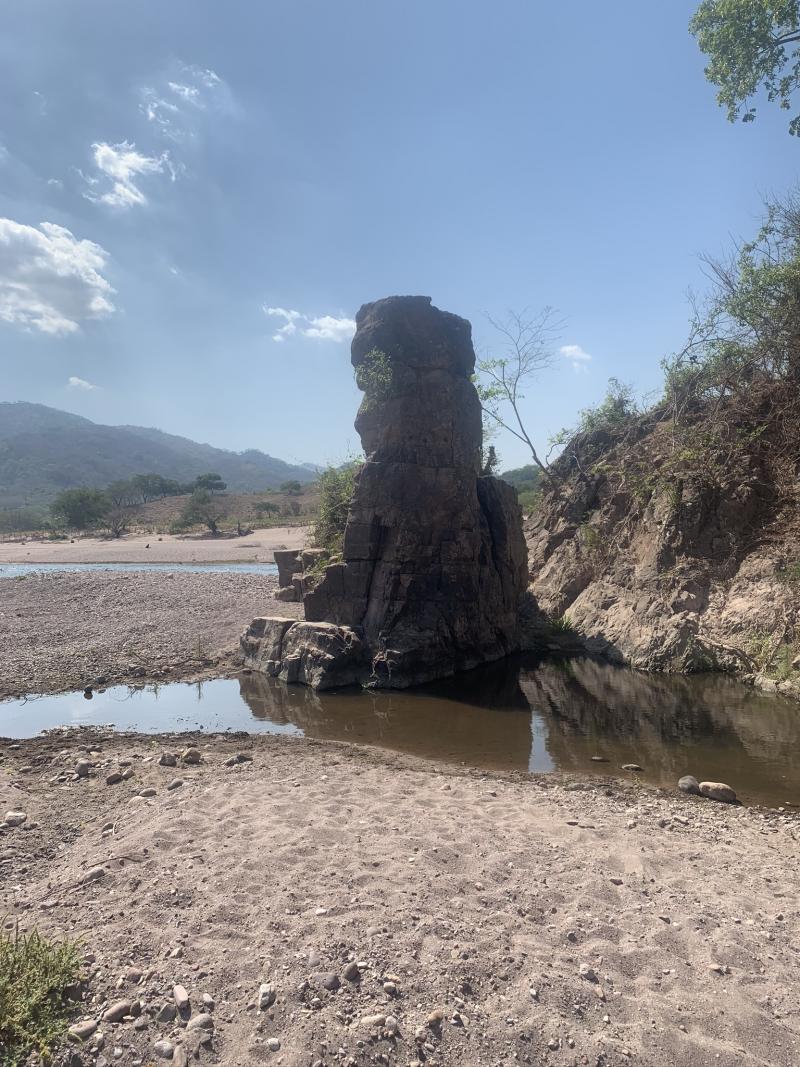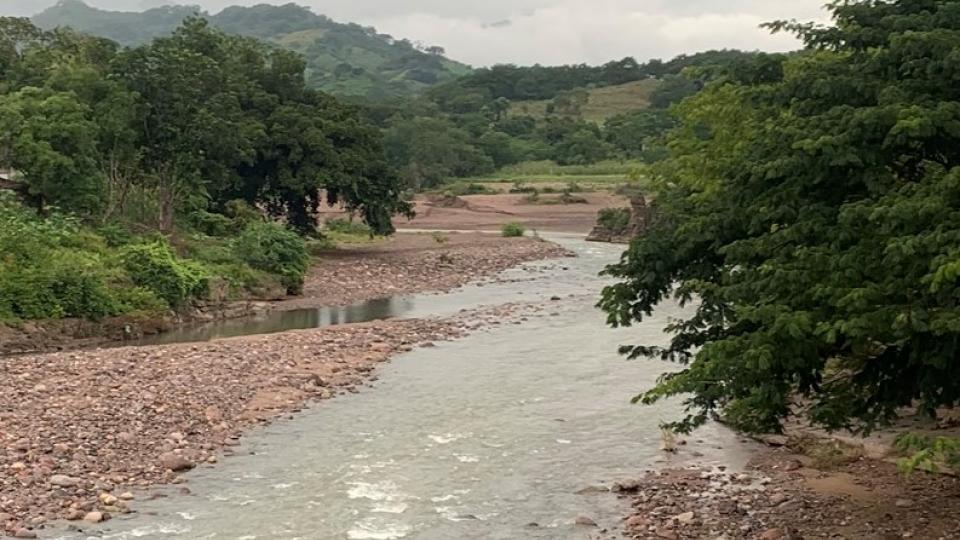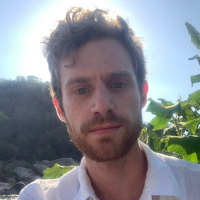
Muxatena, the sacred rock formation at the San Pedro Mezquital River. The site is part of a sacred landscape for surrounding Indigenous communities.
Muxatena, the sacred rock formation at the San Pedro Mezquital River. The site is part of a sacred landscape for surrounding Indigenous communities.
Photograph by Sam Orndorff, 2019.
 This work is licensed under a Creative Commons Attribution 4.0 International License.
This work is licensed under a Creative Commons Attribution 4.0 International License.
La Muxatena is a revered rock formation on the bank of the San Pedro Mezquital River in the Sierra Madre Occidental Mountains of Nayarit, Mexico. In the Indigenous Naayeri language of the nearby town, Presidio de los Reyes, Muxatena means “place where cotton is given.” Here, the river coalesces with one of its many tributaries, the Arroyo Naranjo. Water by the rock column courses strongly during the wet seasons, when only those willing to swim can reach Muxatena.
As their ancestors had done before them, Naayeri, Wixarika, O’dam, and Mexica peoples sojourn to the site from across the watershed. Muxatena is where Indigenous peoples practice spirituality by connecting with ancestors and paying homage to the rock being. This site remains a sacred ceremonial center throughout the year, culminating on 24 June in the largest local festival, Dia de San Juanito, which features syncretic ceremonial practices including Catholic and Nayeeri cosmologies. People make river crossings to revere a statue of the saint, regalia-adorned marches move to music, and the atmosphere is festive—all centered on Muxatena. As was shared by key interviewees during my master’s thesis research, Muxatena is honored by Naayeri people, and prayers of forgiveness are asked that the people be forgiven for losing their Indigenous ways (personal interviews in Presidio de Los Reyes, Mexico, June 2019; October 2019). Muxatena has come to symbolize not only sacred geography but resistance to environmental injustice.
In 2013, the Mexican Federal Electricity Commission (CFE) proposed a large hydroelectric dam (called Las Cruces) on the San Pedro Mezquital River. The mega-project was to be built just upstream from Muxatena—threatening the subsistence lifeways of Indigenous peoples, displacing 16,000 people, and siphoning off a vital life-giving water source to electrify distant urban areas. From 2013–2018, civil society groups organized into a diverse, inter-ethnic, inter-community social movement to challenge the mega-dam (the concrete curtain of which would have measured 188 meters high, nearly as tall as the massive Hoover Dam at 221 meters).

The approximate proposed site of Las Cruces Dam.
The approximate proposed site of Las Cruces Dam.
© D-maps.
Map created by D-maps, edited by Sam Orndorff.
See the original map here.
The copyright holder reserves, or holds for their own use, all the rights provided by copyright law, such as distribution, performance, and creation of derivative works.
Because of the river’s importance to coastal areas downstream, farmers, aqua-culturists, oyster farmers, freshwater shrimp fishers, and environmentalists joined the struggle. Non-Indigenous urbanites in Ruiz, Tuxpan, and as far away as Tepic (Nayarit’s capital) participated. People moved to protect this biodiverse ecosystem, beginning in 2009 when a tourist hotel was slated to be built in the “the largest tropical lagoon complex on the pacific coast of the Americas” (Ezcurra et al 2019) at the mouth of San Pedro. Environmentalists enrolled the wetland into the Ramsar Convention on Wetlands in 2010 and a biosphere reserve called Marismas Nacionales was created. However, threats to the river’s ecological balance persisted in the hydroelectric plan.
The Indigenous-led social movement against the hydroelectric dam combined environmental, legal, and policy challenges and was orchestrated mostly through the international framework of Free Prior Informed Consent—enshrined in the International Labour Organization Convention 169 (1989), and later the United Nations Declaration on the Rights of Indigenous Peoples (2007). Consent, Indigenous activists argued over many years, was never given to build the mega-dam. By 2016, the demands for consent were brought to court. In 2017, Wixarika people halted the project by requesting an amparo (constitutional protection) stipulating that their right to be consulted per UNDRIP and the Mexican constitution was ignored. Meanwhile, government agencies continued to argue that Indigenous groups could simply “re-functionalize” their religion at the edge of the reservoir (SinEmbargo 2018). Determined to prevent the community from losing everything, groups came together at Muxatena to continue their efforts.
Indigenous cultural groups were formulated to imbue the struggle with spirituality, even as it mostly took place in courthouses, public plazas, and government office buildings. Other local groups involved included Nuiwari, The Mexican Center for Environmental Rights (CEMDA), Movement for Dam Affected People and Free Rivers (MAPDER), World Wildlife Fund Mexico, and Inter-American Environmental Defense Action (AIDA). The movement led social media campaigns, made websites, shared petitions, and protested to demand consent about what has happened in their territory. Educators forged a radical consultation pedagogy, making FPIC accessible in public spaces and schools to encourage youth participation. Elementary students joined when the caravan of anti-dam activists met with people from Ejercito Zapatista Liberación Nacional [EZLN] in Chiapas.

Muxatena seen from the bridge between Presidio de Los Reyes and San Pedro Ixcatán. Photograph taken in rainy season (October) from the bridge between San Pedro Ixcatán and Presidio de Los Reyes.
Muxatena seen from the bridge between Presidio de Los Reyes and San Pedro Ixcatán. Photograph taken in rainy season (October) from the bridge between San Pedro Ixcatán and Presidio de Los Reyes.
Photograph by Sam Orndorff, 2019.
 This work is licensed under a Creative Commons Attribution 4.0 International License.
This work is licensed under a Creative Commons Attribution 4.0 International License.
Information sessions held by the government were ridiculed as faulty, and interpreters were lacking. In other meetings people were tricked into signing their “consent” but told that the paper they signed approved a study about feasibility (personal interview, June 2019). Mounting pressure and the increasing costs needed to conduct assessments led the Mexican Environmental Secretary to retire the Las Cruces project in February 2019.
While rituals performed at Muxatena were nearly eradicated from Naayeri culture by Spanish colonization, sites of liberation by the river also include Toacamota and Keiyatsita (Warner 1998). Assimilationist policies (Negrín 2019) have continued the civilizing mission to dismantle the Nayeeri ancestral knowledge base and place-based practices, but the Naayeri people assured that knowledge of this sacred formation would endure. The Naayeri people have strengthened their resolve by relying on sacred sites of the river as deeply meaningful spaces, acknowledging the confines of history, and using international policy. The watershed will always be much more than a physical source of nourishment. Hydroelectric projects, while encountering uneven support among rural communities, are being accurately critiqued by Indigenous communities as “dragging out the colonial era” (Romero and Sasso 2014). While the colonization of Indigenous lands persists, new legal frameworks and appeals to sacred geographies have profoundly changed relations between Indigenous peoples and their environments.
How to cite
Orndorff, Sam. “La Muxatena: A Sacred Rock Formation at the Heart of an Indigenous Social Movement for Environmental Rights.” Environment & Society Portal, Arcadia (Autumn 2020), no. 37. Rachel Carson Center for Environment and Society. https://doi.org/10.5282/rcc/9131.
ISSN 2199-3408
Environment & Society Portal, Arcadia
 This work is licensed under a Creative Commons Attribution 4.0 International License.
This work is licensed under a Creative Commons Attribution 4.0 International License.
2020 Sam Orndorff
This refers only to the text and does not include any image rights.
Please click on the images to view their individual rights status.
- Coyle, Philip E. Náyari History, Politics, and Violence: From Flower to Ash. Tucson, AZ: University of Arizona Press, 2001.
- “Hidroeléctrica Las Cruces violó 6 tratados internacionales.” SinEmbargo, 6 April 2018.
- Negrín, Diana. Racial Alterity, Wixarika Youth Activism, and the Right to the Mexican City. Tucson: The University of Arizona Press, 2019.
- McGee, Brant. “Participation with a Punch: Community Referenda on Dam Projects and the Right to Free, Prior, and Informed Consent to Development.” Water Alternatives 3 (2010):162–184.
- Rea Rodríguez, Carlos R. “La comunidad Náyeri de Presidio de los Reyes ante construcción del Proyecto Hidroeléctrico Las Cruces.” Nueva Epoca 4, no. 14 (2013): 75–87.
- Romero, Hugo, and Jimena Sasso. “Proyectos hídricos y ecología política del desarrollo en Latinoamérica: Hacia un marco analítico.” European Review of Latin American and Caribbean Studies 97 (2014): 55–74.
- Warner, Rick. “‘Ambivalent Conversions’ in Nayarit: Shifting Views of Idolatry.” Journal of Early Modern History 6, no. 2 (2002): 168–184.








